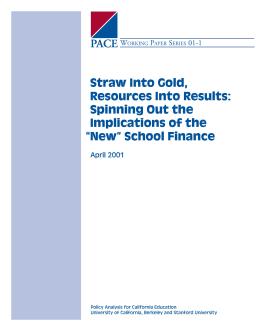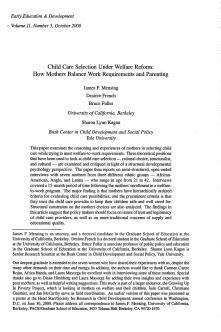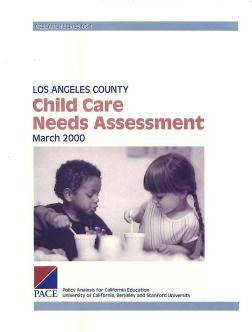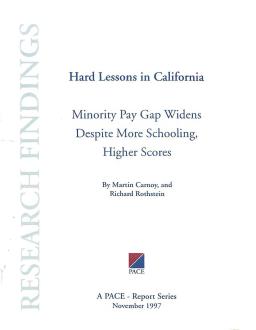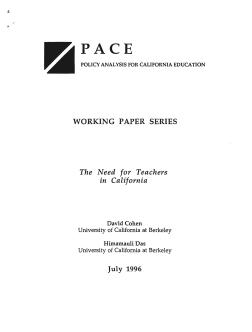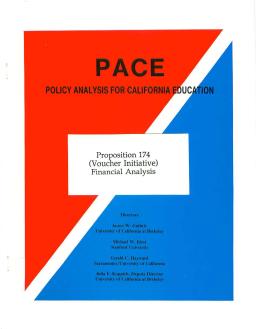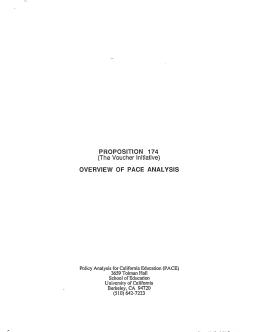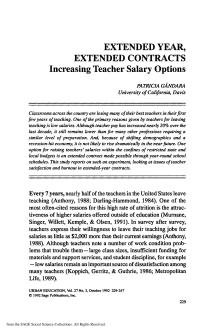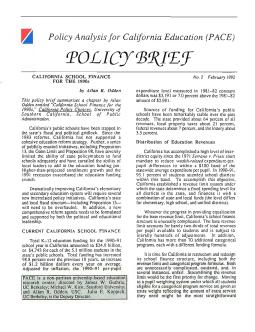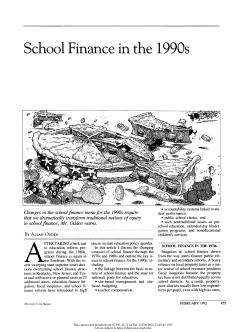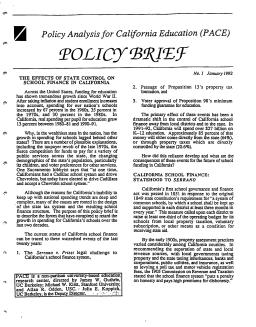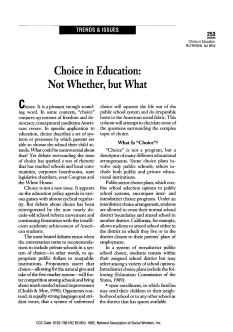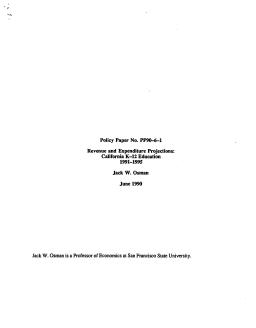Local Innovations Help Working Families
Published
Summary
Many low-income families struggle to afford childcare, even with financial supports. Less than one-fourth of eligible families sign up for subsidies in many communities, leading to disparities in access. The What Works series examines effective programs and policy strategies to increase participation in childcare subsidy programs. The report draws from the Growing Up in Poverty Project, which found highly variable rates of eligible parents using childcare subsidies across CA, CT, and FL. Possible reasons for low utilization and present novel strategies to increase participation are discussed.
Spinning Out the Implications of the 'New' School Finance
Published
Summary
The "new" school finance approach investigates how resources are used within schools and classrooms to enhance educational outcomes, rather than focusing solely on spending patterns. The report reviews literature on resource use in education and suggests that additional funding is not sufficient to improve outcomes. Research should analyze how resources are used within classrooms and schools. Policymakers should develop complementary reforms and enact categorical funding. The report warns that education expenditures keep expanding with little to show for them.
How Mothers Balance Work Requirements and Parenting
Published
Summary
This paper examines how mothers select childcare to meet welfare-to-work requirements. Interviews with seven mothers from different ethnic groups show that trust in childcare providers to keep their children safe is the most important criterion. Structural constraints on their choices are also analyzed. The findings suggest that policymakers should focus on trust and legitimacy of childcare providers in addition to supply and educational quality.
Published
Summary
A study conducted for the Los Angeles County Department of Public Social Services aimed to determine the supply and demand of licensed childcare in the county, with a focus on low-income communities and special types of care. The survey analyzed data at three levels: county-wide, service planning areas, and supervisorial districts. Results showed disparities in childcare supply across the county, with shortages in special types of care and little information on where childcare is needed.
The Influence of Family Structure, Parental Practices, and Home Language
Published
Summary
Latino children are less likely to be enrolled in preschools, even after considering household income and maternal employment. Social factors such as language, child-rearing beliefs, and practices also impact center selection. African American families participate at higher rates, while lower enrollment for Latinos is linked to Spanish-speaking households and cultural preferences. Center selection is part of a broader parental agenda of acculturation to middle-class Anglo commitments to prepare children for school.
California's School Voucher Initiative—Proposition 38
Published
Summary
Proposition 38 allows parents in California to obtain a state chit worth $4,000 and move their child from public to private school, which would significantly affect school financing. This policy brief addresses six key questions about the proposal, including its differences from the 1993 voucher initiative, which families would benefit, how it would impact school spending and taxpayers, and the success of voucher experiments in raising achievement.
Minority Pay Gap Widens Despite More Schooling, Higher Scores
Published
Summary
African Americans and Latinos historically have lower educational attainment, achievement, and wages compared to whites. Narrowing education gaps between minorities and whites should narrow wage gaps. This report analyzes whether California's education gap improvement between minorities and whites led to a parallel reduction in wage gaps. The report finds that the educational attainment and achievement of California's minority youth improved significantly from the 1970s to 1988.
Published
Summary
This baseline analysis examines the projected need for teachers in California based on student enrollment projections, expected rates of new teachers and teacher retirements. However, it does not take into account recent policy changes such as the budget's call for reductions in class size or the proposed changes to teacher credentialing requirements. These changes will impact the need for teachers in California. The analysis shows regional teacher shortages, which are expected to persist despite the new policies.
Published
Summary
The education productivity problem is rising resources but only modestly rising student achievement. Current education reform aims to produce higher student achievement with stable resources. Low student performance may be due to declining social and economic conditions, lack of hard work by students, and lack of parental support. However, research focuses on what schools can do to improve productivity by controlling and improving student achievement. Both education programs and finance structures need to be restructured to accomplish productivity challenges.
Published
Summary
The 1995-96 California state budget increased K-12 education funding by $1 billion, but the additional funds were meant to be used for non-recurring expenses like deferred maintenance and facility upgrades. Lottery revenues were also intended for non-recurring expenses, but schools have come to rely on them for their core instructional program, despite decreasing revenues. This paper reviews the history of the California State Lottery as a funding source for schools and how non-recurring costs are interpreted in a system with shortfalls in core programs.
Financial Analysis
Published
Summary
The Californians will vote on Proposition 174 which will amend the state constitution to establish "scholarships" for kindergarten to 12th-grade schooling. These new schools will be publicly funded but may have privately selected governing boards and religious orientation. It is unclear whether they will be public or private schools. The paper attempts to reduce uncertainty regarding the financial consequences of the proposed voucher plan and address questions about public costs and possible cost savings.
Overview of PACE Analysis
Published
Summary
PACE has analyzed the financial, legal, and social ramifications of Proposition 174, the school choice initiative, so as to provide Californians and policymakers with accurate, unbiased information. This packet contains important questions and answers about the initiative, summaries of PACE's financial analysis and polling report, and background information on PACE and its directors.
The School Voucher Initiative
Published
Summary
The "Parental Choice in Education Initiative" or Proposition 174, will be voted on by Californians on November 2, 1993. PACE has conducted an analysis of the initiative's provisions to provide objective information to policymakers, parents, educators, and the public. PACE is not taking a stance on the initiative but has produced additional materials related to the initiative and the issue of school choice. These materials are listed in the attached report on school choice.
Increasing Teacher Salary Options
Published
Summary
Many new teachers leave the profession due to low salaries, which have only slightly increased despite requiring similar preparation to other professions. A possible solution is extended contracts made possible by year-round school schedules, which could raise salaries within restricted budgets. This study examines the effects of extended-year contracts on teacher satisfaction and burnout.
Published
Summary
California's education system has suffered from a lack of cohesive reform strategy since 1983 due to political and fiscal gridlock, and initiatives like Proposition 13 have limited state and local leaders' ability to fund schools adequately. To improve the system, California needs to overhaul its fiscal structure and formulate a new comprehensive reform agenda with the support of both political and educational leadership.
Published
Summary
School finance has become a prominent issue again due to court decisions and litigation in several states. This article explores school finance changes in the 70s and 80s and outlines key issues for the 90s, including the relationship between finance and education goals, site-based management, teacher pay, accountability, school choice, and nontraditional issues such as preschool and non-educational services for children.
Published
Summary
Funding for education in the US has grown significantly since World War II, but in California, spending for schools has lagged behind other states. Reasons for this include the taxpayer revolt of the late 1970s, competition for funds, changing demographics, and voter preferences. Many of the causes are rooted in the state tax system and school finance structure. Californians used to have a top school system but now have a lower-quality one due to these factors.
Not Whether, But What
Published
Summary
Debate over school choice has been reignited due to the school reform movement and frustration with low academic achievement. The conversation becomes heated when private schools are included in the system of choice, as proponents believe it will foster competition and improve schools, while opponents argue it will harm public schools and society. This article aims to shed light on the complex issue of school choice.
California and Senate Bill 813
Published
Summary
In 1983, the California legislature enacted a series of incentive programs intended, in part, to encourage local school districts to devote more resources toward instructional expenditures. Analysis of district response to those incentives shows they were more effective in directing spending toward direct instruction than were general or categorical grants. However, it appears that as the incentive funds were rolled into general aid revenues, district spending patterns began to revert to the same distribution of expenditures observed prior to enactment of the incentives.
California K–12 Education 1991–1995
Published
Summary
This report discusses the importance of forecasting revenues and expenditures for public sector planning and budgeting. It highlights three characteristics of California's recent experience. First, K-12 funding rose 91% from 1980 to 1989, but real revenue growth was tempered by inflation. Second, California relies more on state revenues for K-12 education than the rest of the US. Third, California's "effort" in raising K-12 revenues in 1986 was lower than the US average, and revenue efforts for both schools and other public functions are below the national average.
A Comparison of Education Reforms in the United States and Great Britain
Published
Summary
The new global economy is reshaping education worldwide, necessitating policies that expand access and enhance quality. Despite different educational systems, similar issues need to be addressed, resulting in an international convergence of education policies. The article discusses the emerging economy, educational challenges, policy alternatives, and compares recent reforms in the US and UK.

